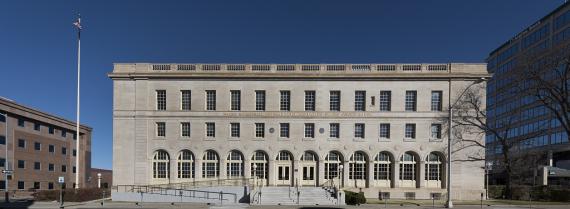Location: 400 Rood Ave, Grand Junction, CO 81501
The Wayne Aspinall Federal Building and U.S. Courthouse is architecturally significant as an important example of a Italian Renaissance Revival style government building designed by Supervising Architect of the Treasury James Wetmore in 1918 with a significant addition in 1940 by Wetmore’s successor, Louis A. Simon. In addition, it is historically significant because of its association with an important U.S. congressional leader, Wayne N. Aspinall.
Architectural Significance
Constructed in 1918, the Aspinall FB-CT was the first permanent post office building constructed in Grand Junction. Today, it maintains a place as the city’s most important and architecturally refined civic structure. The building is located within one block of the central business district. It originally shared the block with the Masonic Temple and the YMCA building, the three buildings together comprising a grouping of monumental civic structures. These have since been replaced with modern structures, notably the nine-story steel and glass office complex to the west. The site at the corner of Rood and 4th Street is distinguished from the surrounding areas by its traditional landscaping of grass, ornamental trees, and prominent corner flagpole.
The building is a three-story plus basement steel and concrete structure with Indiana limestone ashlar facade and parapet balustrade. True to the Renaissance Revival style that grew out of the City Beautiful movement at the end of the 19th century, each story is uniquely detailed to reinforce the horizontality. As originally constructed, the second floor windows were topped with limestone pediments at alternate openings. Removal of these pediments in the course of the 1938-1940 expansion was most likely considered a modernization, and this change, in fact, is more consistent with the Italian Renaissance Revival style popular in the 1930s.
Historic Significance
In June 1910, the U.S. Congress authorized the use of $100,000 for construction of the first permanent post office in Grand Junction. The appropriation was soon perceived as inadequate for the design program, but it was not until 1915 that the budget was expanded to $175,000 and the design was completed by architect James Wetmore for a two-story post office and courthouse building. A major design change that added a third story to the building was made just as construction was begun in 1916. These changes, as indicated by the record of construction documents, were undertaken as a change to the contract in progress. The new three-story building was completed and postal operations moved in on March 22, 1918.
In the late 1930s, the Post Office required additional space, and in 1938 designs for an addition began. Designed by Louis A. Simon of the Treasury, the addition was completed in 1940, extending the structure 45-10 to the east. The south and east facades matched the original building construction and are clad in limestone. At the rear, north elevation, the building is clad in a light colored Denver faced brick. The addition disrupted the symmetry of the main facade and the original granite steps had to be removed and re-centered. In addition, an accessible ramp was constructed parallel to the rear facade, extending east from the rear door to the buildings end. In the late 1930s, the Federal Works Agency Section of Fine Arts commissioned Louise Emerson Ronnebeck to paint a mural to be displayed in the Post Office Lobby. Installed over the Postmasters door in the southeast end of the lobby addition, the painting titled Peach Harvest, displays topography of the area and the peach harvest in Grand County.
Democratic Representative Wayne Aspinall’s association with the building spans from 1949 to 1973. During that time he served in the U.S. Congress, serving his last 14 years as the Chairman of the House Interior and Insular Affairs Committee. Wielding considerable influence on the nation’s reclamation activities, Aspinall is credited with the passage of over 1,000 bills during his tenure on this committee.
By order of Public Law 92-520 of October 21, 1972, the U.S. Congress officially changed the name of the Grand Junction Federal Building to Wayne N. Aspinall Federal Building and U.S. Courthouse in honor of the former congressman from the Grand Junction area.
Building Facts
- Architect: James A. Wetmore
- Construction Dates: 1915-1918
- GSA Building Number: CO0018ZZ
- Landmark Status: Listed in the National Register of Historic Places

 U.S. General Services Administration
U.S. General Services Administration
